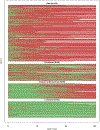Long-term seizure diary tracking habits in clinical studies: Evidence from the Human Epilepsy Project
- PMID: 38754255
- PMCID: PMC11189103
- DOI: 10.1016/j.eplepsyres.2024.107379
Long-term seizure diary tracking habits in clinical studies: Evidence from the Human Epilepsy Project
Abstract
Objective: To characterize seizure tracking patterns of people with focal epilepsy using electronic seizure diary entries, and to assess for risk factors associated with poor tracking.
Methods: We analyzed electronic seizure diary data from 410 participants with newly diagnosed focal epilepsy in the Human Epilepsy Project 1 (HEP1). Each participant was expected to record data each day during the study, regardless of seizure occurrence. The primary outcome of this post-hoc analysis was whether each participant properly tracked a seizure diary entry each day during their study participation. Using finite mixture modeling, we grouped patient tracking trajectories into data-driven clusters. Once defined, we used multinomial modeling to test for independent risk factors of tracking group membership.
Results: Using over up to three years of daily seizure diary data per subject, we found four distinct seizure tracking groups: consistent, frequent at study onset, occasional, and rare. Participants in the consistent tracking group tracked a median of 92% (interquartile range, IQR: 82%, 99%) of expected days, compared to 47% (IQR:34%, 60%) in the frequent at study onset group, 37% (IQR: 26%, 49%) in the occasional group, and 9% (IQR: 3%, 15%) in the rare group. In multivariable analysis, consistent trackers had lower rates of seizure days per tracked year during their study participation, compared to other groups.
Significance: Future efforts need to focus on improving seizure diary tracking adherence to improve quality of outcome data, particularly in those with higher seizure burden. In addition, accounting for missing data when using seizure diary data as a primary outcome is important in research trials. If not properly accounted for, total seizure burden may be underestimated and biased, skewing results of clinical trials.
Keywords: Electronic seizure diary; Seizure outcomes; Seizure tracking.
Copyright © 2024 Elsevier B.V. All rights reserved.
Figures
References
MeSH terms
Grants and funding
LinkOut - more resources
Full Text Sources
Medical


